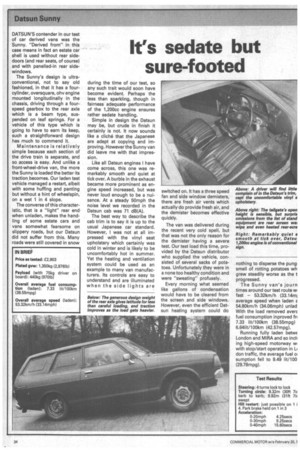It's sedate but sure-footed
Page 28

If you've noticed an error in this article please click here to report it so we can fix it.
DATSUN'S contender in our test of car derived vans was the Sunny. "Derived from" in this case means in fact an estate car shell is used without rear sidedoors (and rear seats, of course) and with panelled-in rear sidewindows.
The Sunny's design is ultraconventional, not to say old fashioned, in that it has a fourcylinder, oversquare, ohv engine mounted longitudinally in the chassis, driving through a fourspeed gearbox to the rear axle which is a beam type, suspended on leaf springs. For a vehicle of this type which is going to have to earn its keep, such a straightforward design has much to commend it.
Maintenance is relatively simple because each section of the drive train is separate, and so access is easy. And unlike a front-wheel-drive van, the more the Sunny is loaded the better its traction becomes. Our laden test vehicle managed a restart, albeit with some huffing and panting but without a hint of wheelspin, on a wet 1 in 4 slope.
The converse of this characteristic, that is a "light" rear end. when unladen, makes the handling of some estate cars and vans somewhat fearsome on slippery roads, but our Datsun did not suffer from this. Many roads were still covered in snow during the time of our test, so any such trait would soon have become evident. Perhaps the less than sparkling, though in fairness adequate performance of the 1,200cc engine ensures rather sedate handling.
Simple in design the Datsun may be, but crude in finish it certainly is not. It now sounds like a cliché that the Japanese are adept at copying and improving. However the Sunny van did leave me with that impression.
Like all Datsun engines I have come across, this one was remarkably smooth and quiet at tick over. A burble in the exhaust became more prominent as engine speed increased, but was never loud enough to be a nuisance. At a steady 50mph the noise level we recorded in the Datsun cab was 71 dB(A).
The best way to describe the cab trim is to say it is up to the usual Japanese car standard. However, I was not at all impressed with the vinyl seat upholstery which certainly was cold in winter and is likely to be uncomfortably hot in summer. Yet the heating and ventilation system could be used as an example to many van manufacturers. Its controls are easy to understand and are illuminated when the side lights are switched on. It has a three speed fan and side window demisters, there are fresh air vents which actually do provide fresh air, and the demister becomes effective quickly.
The van was delivered during the recent very cold spell, but that was not the only reason for the demister having a severe test. Our test load this time, provided by the Datsun distributor who supplied the vehicle, consisted of several sacks of potatoes. Unfortunately they were in a none too healthy condition and were "sweating" profusely.
Every morning what seemed like gallons of condensation would have to be cleared from the screen and side windows. However, even the efficient Datsun heating system could do
nothing to disperse the pung, smell of rotting potatoes wh grew steadily worse as the t progressed.
The Sunny van's journ times around our test route w, fast — 53.32km/h (33.14mi average speed when laden e 54.80km/h (34.06mph) unlad With the load removed avers fuel consumption inproved In 7.33 lit/100km (38.55mpg) 6.6411t/100km (42.57mpg).
Running fully laden betwE London and MIRA and so inch ing high-speed motorway w, with stop/start operation in L4 don traffic, the average fuel cr sumption fell to 9.49 lit/100 (29.78mpg).


















































